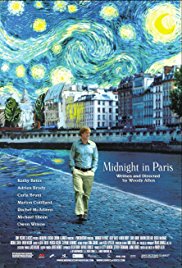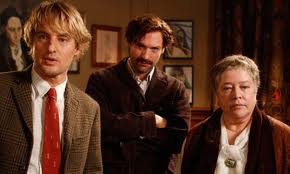1. What is the difference between the world that Gil Pender inhabits in the present and the world that he sees in his midnight travels back in time? How does this relate to the theme of the movie?
Suggested Response:
There are many ways to describe the problems with the present: the people Gil is with are shallow; the world is all glitzy style and no substance; there is no passion to the world in which Gil lives. In the 1920s, Gil sees action, passion and a total devotion to art. He sees a period of time when creating was more important than selling. Students may note specific inspirational characters that he meets in these moments of magical realism. As to theme, Gil eventually realizes that he has no choice but to be in the present and that he must embrace the future, using inspiration and lessons from the past as they apply.
2. Nostalgia is a sentimental longing for the past. In this film Gil Pender is nostalgic for the Paris of the 1920s. Paul, the man who sleeps with Gil’s fiancé, is also quite knowledgeable about the past. Gil calls Paul a pedantic pseudo-intellectual. Paul, obviously with Gil in mind, has the following to say about nostalgia.
PAUL: You know, nostalgia is denial. Denial of the painful present.
INEZ: Oh, Gil is a complete romantic. He would be more than happy living in a complete state of perpetual denial.
PAUL: And the name of this fallacy is called “golden-aged thinking.”
INEZ: Touche.
PAUL: The erroneous notion that a different time period is better than the one one’s living in. It’s a flaw in the romantic imagination of those people who find it difficult to cope with the present.
By the end of the movie, Gil’s view of the 1920s has changed to some extent. He talks about a dream that he lived in the past when there were no antibiotics, dishwashers, or 911. What is the scriptwriter trying to tell us about the uses of the past.
Suggested Response:
Paul uses his knowledge about the past to impress people, but he has no passion for it and he does not really learn anything that is important to his life. Like Inez and her parents, Paul is shallow. Gil has a great passion for the past throughout the movie but by the end of the story he realizes that we must live in the present and that the proper use of the past is to take the lessons that it provides and use them to help us live well. The symbol for Gil using the knowledge of the past and putting it to good use in the present is that Gertrude Stein reads and comments on his book. Ms. Stein was famous for performing this function for writers of the Lost Generation.
3. The Gertrude Stein character says, “It’s the artist’s job not to succumb to despair but to find an antidote to the emptiness of existence.” Gil Pender says that “[I]t’s my job as a writer to try and come up with reasons why despite life being tragic and unsatisfying, it’s still worth it.” Steve Chbosky, author of The Perks of Being a Wallflower describes art as a love song from the artist to the audience/reader. For him, the artist describes shared life experiences and feelings, which establishes a sense of community between people. He states that when he is able to do that, he feels infinite.1 There have been thousands of different ways that artists have described what they do. What do you think is the role of an artist? Explain your reasons.
Suggested Response:
There is no one correct response, the purpose of this question is to get students to think about the issue. Some students might say that the purpose of art is to express the beauty of existence; others might say that it is to provide new, interesting and/or beautiful interpretations of existence. Teachers might note the pessimism of both the statement by Pender and the statement by the Gertrude Stein character. This probably relates to the sense of despair after the First World War. Chbosky’s idea is more optimistic.
4. William Faulkner said, “The past is never dead. It’s not even past.” In what sense is this statement true and in what sense is it not true? Explain your reasoning.
Suggested Response:
This is no one correct response. A good response would point out that it is true because what has happened in the past does affect the present and the future. It’s true because many people live as if it were the past, fewer today than in prior times, but that still occurs. It is true because those who do not know the history of the past are condemned to repeat it. It is not true in the sense that the past is completed, can never be changed, nor can it return. It only influences the present or the future in ways that we permit that to occur.
5. What factors in Gil’s present life make him feel dissatisfied and drawn to the Paris of the 1920s?
Suggested Response:
There is no one correct response because there is a lot about the present that Gil finds dissatisfying. Gil is engaged to a superficial young woman whose parents are materialistic and who oppose his political viewpoint; his associates are pedantic and boring; he is a rich man who has earned his wealth by selling out his craft and writing for money rather than for art; he is having difficulty writing a novel and had failed in an earlier attempt.
6. What seems to be so attractive about the life Gil sees in Paris when he travels backward in time?
Suggested Response:
Gil sees action, passion and total devotion to art. He sees a period of time when creating was more important than selling. Students may note specific inspirational characters that he meets in these moments of magical realism.
7. Why does Adriana, with Gil in tow, arrive in La Belle Epoque of the 1890s when she travels back in time? It’s the same reason that the detective found himself in the 18th century.
Suggested Response:
Those are the years that they think are France’s golden age.
8. Adriana asks Gil: “Surely you don’t think the 20s are a golden age?” Gil responds, “To me they are.” What does this tell you?
Suggested Response:
That nostalgia is subjective and the perfect age of the past will be different for different people.
See Discussion Questions for Use With any Film that is a Work of Fiction.



